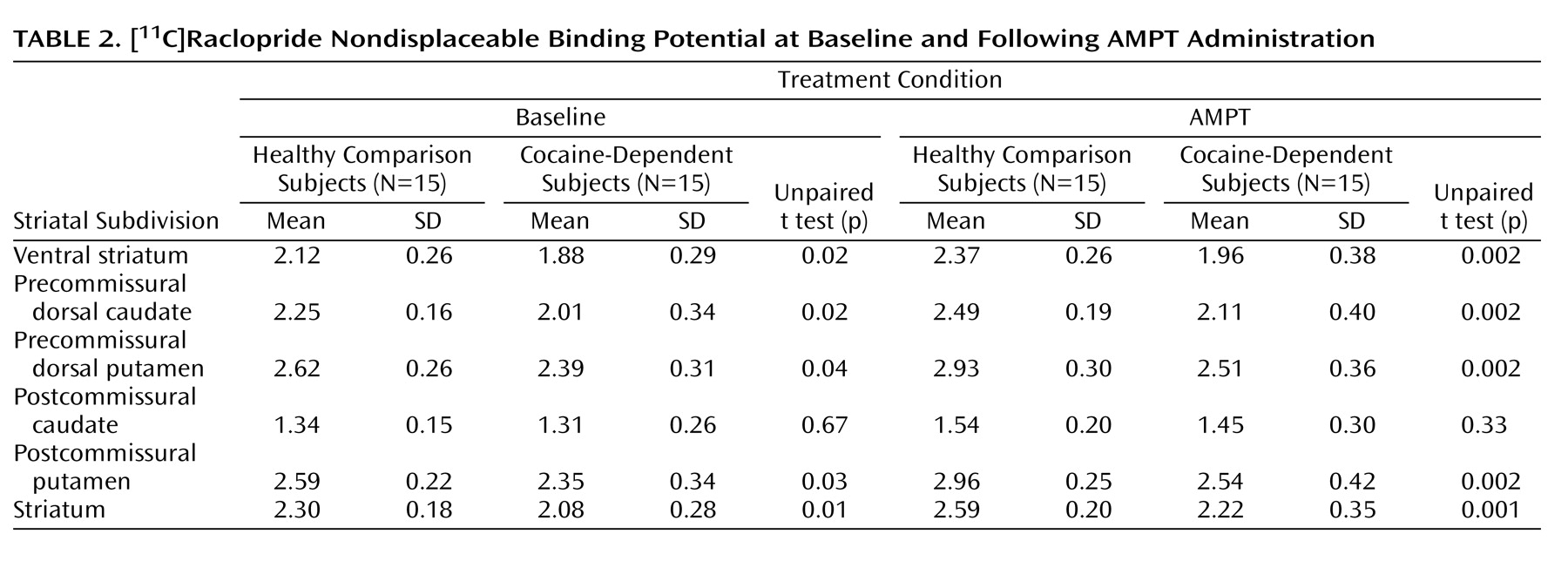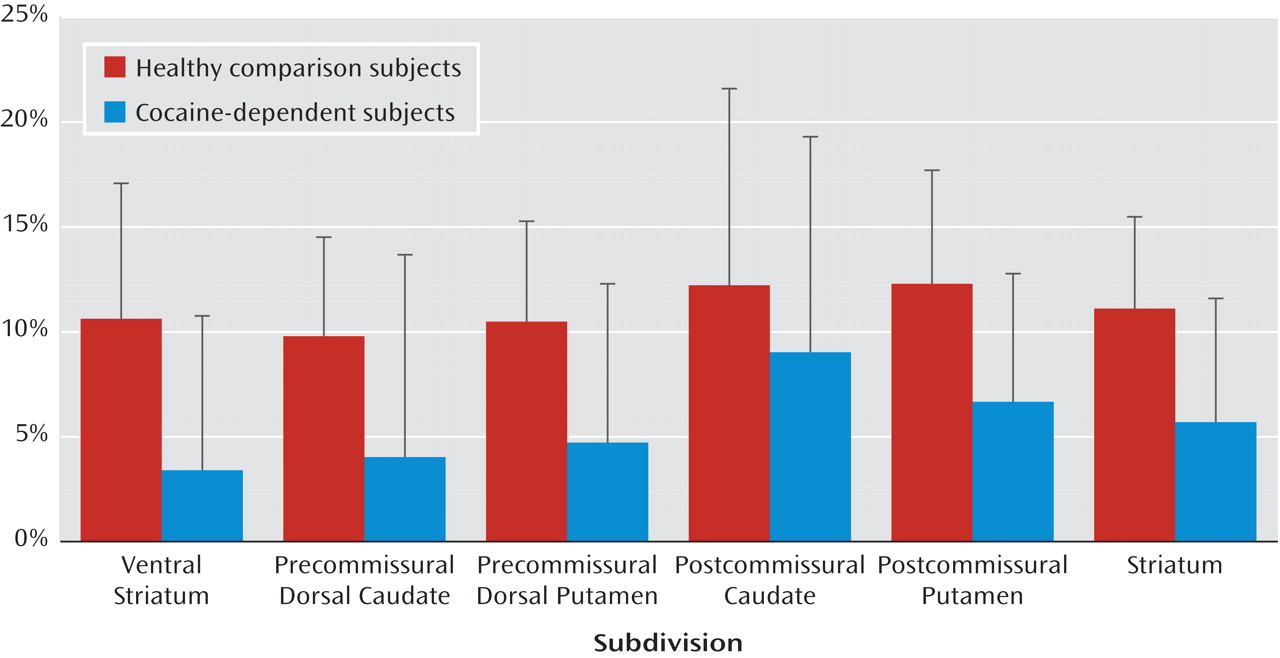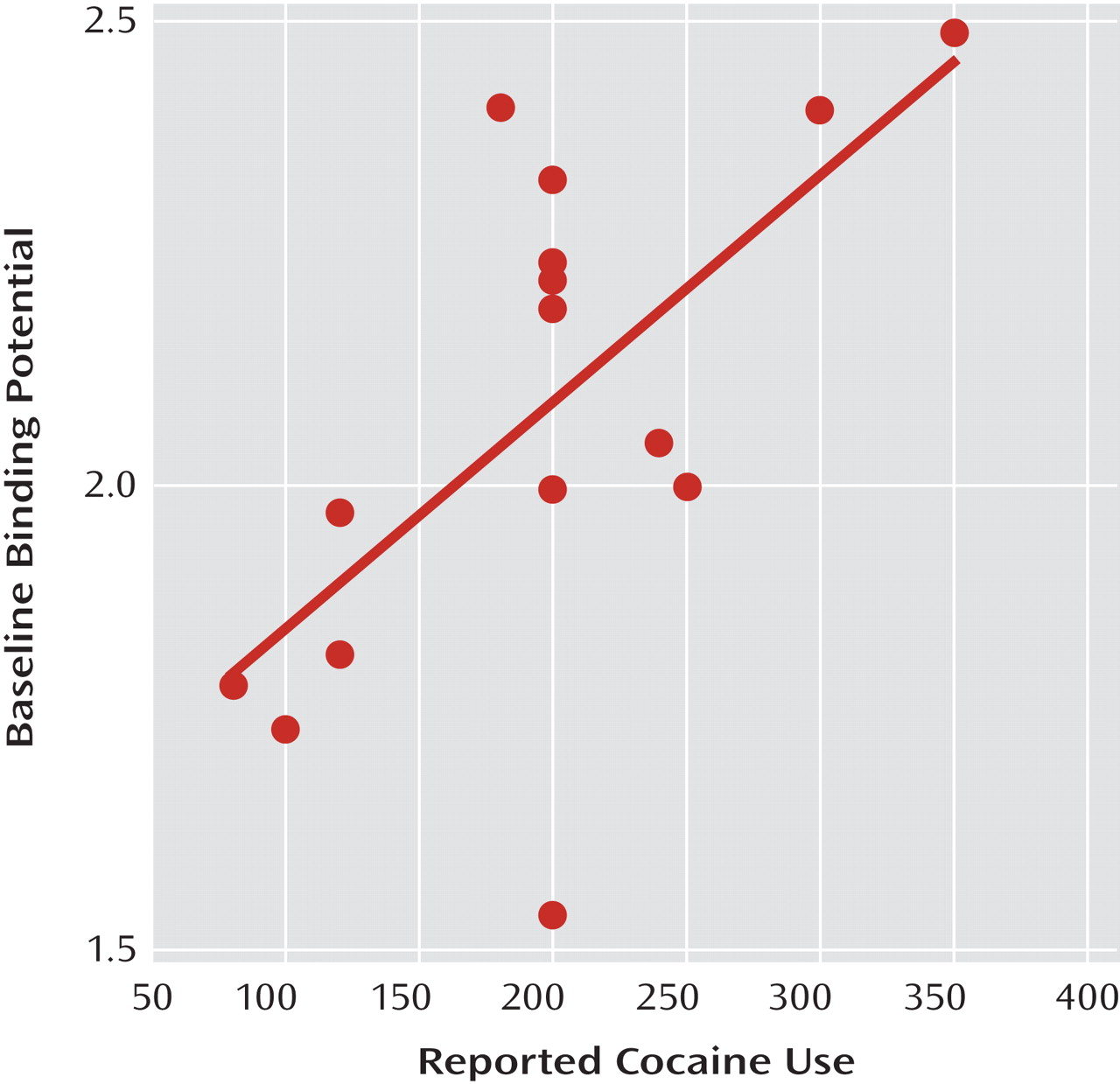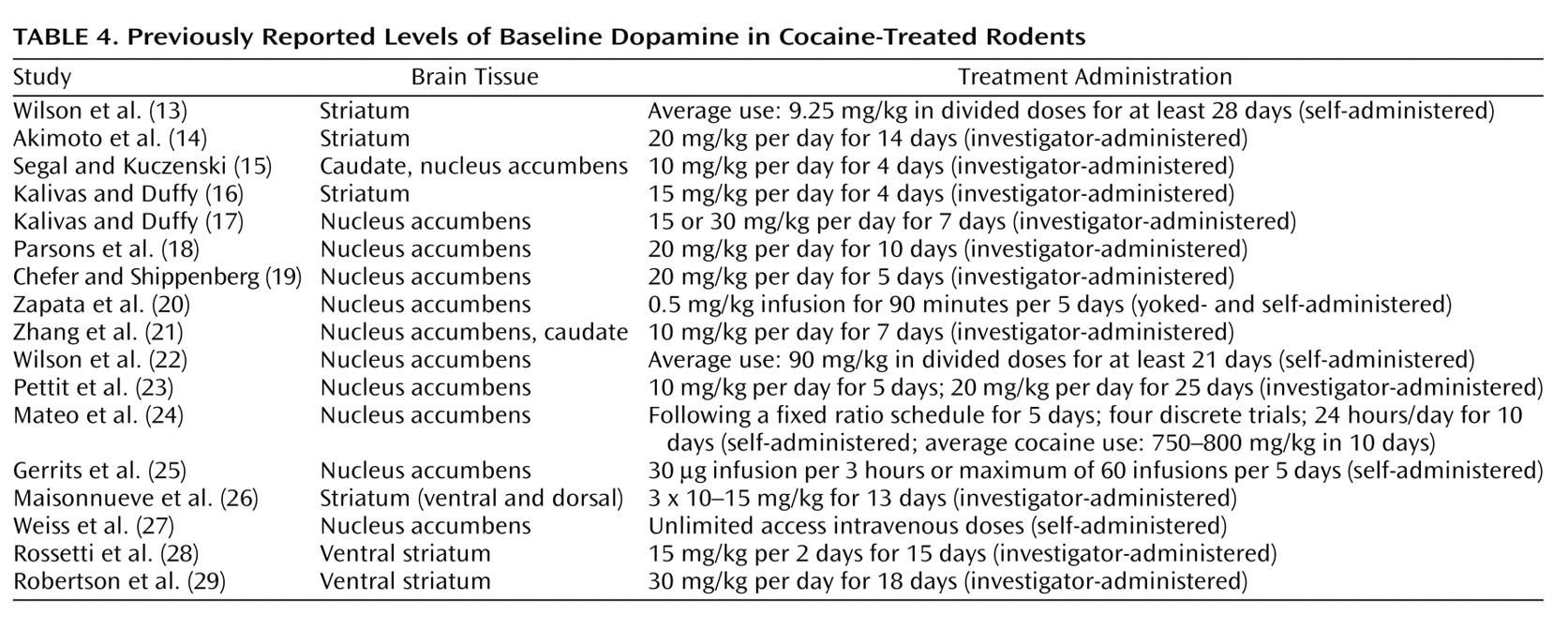Only one previous study, conducted by Abi-Dargham et al.
(4), has measured levels of endogenous dopamine at the D
2 /D
3 receptors in a psychiatric population, which showed that schizophrenia patients exhibited a higher level of dopamine relative to comparison subjects. Abi-Dargham et al. demonstrated that AMPT administration resulted in a 19% increase in [
123 I]iodobenzamide binding in subjects with schizophrenia relative to only a 9% increase in matched healthy comparison subjects. Importantly, no difference in D
2 /D
3 .receptor binding potential was seen between these two groups prior to dopamine depletion. However, after AMPT administration, schizophrenia subjects were found to have higher binding potential (11%) relative to comparison subjects. Thus, the study demonstrated that between-group differences in D
2 /D
3 receptor binding potential can be masked by differences in the level of endogenous dopamine occupying the D
2 /D
3 receptors.
In order to test the possible contribution of receptor occupancy by endogenous dopamine to the observed difference in [ 11 C]raclopride binding potential between cocaine-dependent subjects and comparison subjects, we used [ 11 C]raclopride to measure D 2 /D 3 receptors before and after acute dopamine depletion with AMPT in a group of cocaine-dependent subjects (N=15) and matched healthy comparison subjects (N=15).
Method
The present study was approved by the New York State Psychiatric Institute Institutional Review Board, and all participants provided written informed consent. The cocaine-dependent volunteers were 25 to 45 years old and medically healthy and fulfilled DSM-IV criteria for cocaine dependence, with no other current axis I diagnosis. In addition, they were not seeking treatment but were informed that a referral for treatment was available. Healthy comparison subjects were between the ages of 25 and 45 years old and had no current or past DSM-IV axis I disorder.
Fifteen cocaine-dependent subjects (13 men/two women; mean age: 39 years [SD=6 years]) and 15 healthy comparison subjects (13 men/two women; mean age: 39 years [SD=5 years], p=0.8) were enrolled in the study. Subjects were matched for 1) ethnicity (healthy comparison subjects: African American [N=13], Caucasian [N=2]; cocaine-dependent subjects: African American [N=13], Caucasian [N=1], Hispanic [N=1]) and 2) cigarette smoking (healthy comparison subjects smoked 10 cigarettes per day [SD=4] and included three nonsmokers; cocaine-dependent subjects smoked 11 cigarettes per day [SD=5] and included two nonsmokers). Cocaine-dependent subjects reported smoking crack cocaine an average of 13.4 years (SD=6.4 years) and spending $196 (SD=$73) weekly over the past 6 months.
All subjects were scanned using PET, with the dopamine receptor radiotracer [
11 C]raclopride, at baseline and again following AMPT administration. Subjects were admitted to the Irving Center for Clinical Research for the administration of AMPT. Cocaine-dependent subjects were admitted 14 days prior to the baseline PET and underwent random urine toxicology tests to confirm cocaine abstinence. Healthy comparison subjects were admitted prior to the first dose of AMPT. The dose of AMPT was administered using a sliding scale, adjusted to a participant’s weight, as follows: 59–75 kg=1,000 mg per dose; 76–92 kg=1,250 mg per dose; 93–115 kg=500 mg per dose. Eight doses of AMPT were administered every 6 hours beginning 49 hours prior to the second PET (post-AMPT) scan, with the last dose administered 1 hour prior to the second scan. Since AMPT can produce crystalluria, all subjects 1) received sodium bicarbonate, 1,300 mg daily, 2) were required to drink 4 liters of water every 24 hours, and 3) underwent daily urinalysis of AMPT administration. A frequent side effect of AMPT is extrapyramidal symptoms. These symptoms were assessed daily using the Extrapyramidal Symptom Rating Scale
(7), a scale designed to detect drug-induced movement disorders.
PET Scans
[
11 C]Raclopride was administered as a bolus with constant infusion, and PET scans were acquired using ECAT EXACT HR+ (Siemens/CTI, Knoxville, Tenn.) in a three-dimensional mode of eight 5-minute-duration frames (obtained 40 to 80 minutes after the initial [
11 C]raclopride bolus), as previously described
(8) . A 10-minute transmission scan was obtained prior to acquisition of the emission data. All participants underwent two PET scans with [
11 C]raclopride (one at baseline and one following AMPT administration). Four venous samples were analyzed to obtain the plasma concentration of nonmetabolized [
11 C]raclopride (μCi/ml), as described in a previous report
(8) . A plasma sample for analysis of homovanillic acid levels was obtained for each scan 20 minutes prior to injection and assayed by gas chromatography as previously described
(4) .
Receptor availability of D
2 /D
3 was estimated for [
11 C]raclopride nondisplaceable binding potential (BP
ND ), which was defined using the following equation (regional tissue distribution volume=V
T [ml/cm
3 ]; region of interest=ROI; cerebellum=CER; f
ND =free fraction in nonspecific distribution brain volume; B
max = concentration of D
2 /D
3 receptors [nmol per gram of tissue]; K
D =inverse of the affinity of the radiotracer for the receptor [see reference 9 for details]):
The cerebellum was used as the reference region. The regional tissue distribution volume for the cerebellum was measured for each condition in order to assess the effect of AMPT on nonspecific binding between groups, as described elsewhere (8). The free fraction of [ 11 C]raclopride in the plasma was compared across conditions and groups.
The percent occupancy of D
2 /D
3 receptors as a result of endogenous dopamine was calculated as the percent change in nondisplaceable binding potential (%ΔBP
ND ), using the following equation:
Region of Interest Analysis
Image analysis was performed using MEDx (Sensor Systems, Inc., Sterling, Va.). Each subject underwent magnetic resonance imaging (MRI), acquired using a GE Signa EXCITE 3T/94-cm scanner (GE Medical Systems, Milwaukee). Regions of interest were drawn from each subject’s MRI, and both motion correction and PET-MRI registration were performed as described elsewhere
(8,
9) . The striatum was divided into the caudate, putamen, and ventral striatum as described in a previous report
(10) . Briefly, the ventral striatum was identified using set landmarks, and the caudate and putamen were further subdivided along their rostral-caudal axes using the anterior commissure. The following regions of interest were derived: ventral striatum, which includes the nucleus accumbens and ventral portions of the caudate and putamen; precommissural dorsal caudate; precommissural dorsal putamen; postcommissural caudate; and postcommissural putamen. This method of subdividing the striatum was developed to reflect the functional input to the striatum in several ways. First, the ventral striatum receives input from the limbic brain regions. Second, the pre- and postcommissural caudate and precommissural putamen largely receive input from the associative cortex. Third, the postcommissural putamen is largely involved in sensorimotor processing (see reference
10 for details). Activity from the right and left regions were averaged together, and a weighted average (weighted by subregion volume) was used to derive nondisplaceable binding potential for the striatum as a whole.
Statistical Analysis
Group demographic comparisons were performed with unpaired t tests. Differences in [ 11 C]raclopride nondisplaceable binding potential and percent change in nondisplaceable binding potential between cocaine-dependent and healthy comparison subjects were analyzed using a repeated-measures analysis of variance (ANOVA), with the region of interest as the repeated measure and diagnostic group as the cofactor (SPSS Statistics, Chicago). The Huynh-Feldt correction was used in the event of violations of sphericity assumptions.
Discussion
The results of the present study demonstrate that cocaine-dependent subjects have lower levels of endogenous dopamine relative to healthy comparison subjects. Thus, the decrease in baseline D 2 /D 3 receptor binding potential (nondisplaceable binding potential) seen in the cocaine-dependent subjects cannot be attributed to differences in the percentage of D 2 /D 3 receptors occupied by dopamine, and the endogenous dopamine levels may have masked even greater differences between cocaine-dependent and healthy comparison subjects than those differences observed previously.
We assumed that the AMPT-induced increase in D
2 /D
3 receptor binding potential resulted from a reduction in the percentage of receptors bound to endogenous dopamine rather than upregulation of D
2 /D
3 receptors in the setting of dopamine depletion. This assumption was based on previous studies of rodents
(3,
11,
12), which showed that acute dopamine depletion with reserpine, 6-hydroxydopamine, or AMPT did not produce D
2 /D
3 receptor upregulation in the short-term. Notably, the investigators using AMPT
(3) designed their experiment in rodents to emulate their analysis of human subjects, and high-dose AMPT (400 mg/kg per day) was administered in the rodents for the same time period used for the human subjects. Compared with saline-treated animals, no difference was seen in D
2 /D
3 receptor B
max, indicating that receptor upregulation did not occur. However, based on the literature published to date, it is unknown if there are differences in receptor externalization between humans and rodents. In addition, although this dosing regimen is expected to result in a 70%–80% depletion of striatal dopamine
(4), the exact degree of depletion is not known in the absence of animal studies.
The lower levels of endogenous dopamine seen in the present study are consistent with some, although not all, preclinical studies of rodents. Previous studies
(13 –
29) have shown either no change or a decrease in the levels of endogenous dopamine in rodents following chronic exposure to cocaine. As outlined in
Table 4, these studies are almost evenly split between those showing a decrease in baseline levels of dopamine in cocaine-treated rats relative to comparison rats and those showing no difference in this measure. The methods between these studies vary in terms of the amount of cocaine administered, method of cocaine administration (self-administered, investigator-administered, or yoked-administered), and duration of cocaine administration. In general, the studies showing a decrease in endogenous dopamine used a higher dose of cocaine for longer periods of time. In addition, more of these studies used cocaine self-administration, which may be a more accurate reflection of the pattern of cocaine use in humans.
In the present study, cocaine dependence was associated with a lower AMPT-induced change in [
11 C]raclopride binding in the striatum, measured as a whole, and in each of the striatal subdivisions, with the exception of the posterior caudate. There was no significant difference in the baseline measures of D
2 /D
3 receptor binding potential in this brain region between cocaine-dependent and comparison subjects. This finding is consistent with our previous study
(2), which also showed no difference in baseline measures of D
2 /D
3 receptor binding potential in the posterior caudate in a separate cohort of cocaine-dependent and comparison subjects. Together, these data suggest that the posterior caudate is spared in cocaine dependence, both in terms of baseline D
2 /D
3 receptor binding potential and levels of endogenous dopamine, although the rationale for this is not clear. The caudate posterior to the anterior commissure has been rarely investigated in animal studies, and thus it is unknown if there is some inherent difference in this brain region that would cause it to be spared. Moreover, to our knowledge, no other imaging investigator group has compared D
2 /D
3 receptor binding potential between cocaine-dependent and comparison subjects in this brain region, and it will be important for this finding to be replicated.
Although, to the best of our knowledge, this is the first report to measure levels of endogenous dopamine in cocaine-dependent subjects, several previous studies have used PET or SPECT and AMPT to estimate endogenous dopamine levels in healthy comparison subjects. Laruelle et al.
(3) used [
123 I]iodobenzamide and AMPT (8 g over a 48-hour period), which produced a 28% (SD=16%) increase in binding potential and a 70% (SD=12%) decrease in homovanillic acid levels in nine healthy subjects. Abi-Dargham et al.
(4) used this same method to assess the occupancy of D
2 /D
3 receptors by endogenous dopamine in schizophrenia patients relative to healthy comparison subjects. AMPT-induced dopamine depletion significantly increased D
2 /D
3 receptor availability by 19% (SD=11%) in patients with schizophrenia relative to 9% (SD=7%) in healthy comparison subjects. Verhoeff et al.
(5,
6) conducted two studies using [
11 C]raclopride to measure levels of endogenous dopamine in healthy comparison subjects. The first study reported that AMPT (4.5 g over a 25-hour period) increased [
11 C]raclopride binding by 18.5% (SD=3.0%) in the striatum and produced a 71% (SD=11%) decrease in plasma homovanillic acid levels in six healthy comparison subjects
(5) . In their second study, six comparison subjects were imaged with [
11 C]raclopride, and AMPT administration (5.35 g over a 29-hour period) resulted in a significant increase in binding potential (13.3% [SD=5.9%]) in the striatum and decreased homovanillic acid levels (62% [SD=17%])
(6) .
As a result of limited scanner resolution, these previous studies imaged the striatum as a whole and could not separate the signal among the caudate, putamen, and ventral striatum. More recently, studies using the PET radiotracer [
18 F]fallypride, which also labels the D
2 /D
3 receptor, and AMPT have measured endogenous dopamine in the subdivisions of the striatum using a high-resolution PET scanner. Riccardi et al.
(30) reported that AMPT (71.4 mg/kg) increased binding potential by 8.8% in the caudate, 11.2% in the putamen, and 10.6% in the ventral striatum in healthy subjects. However, a subsequent study
(31) showed no effect of a lower dose of AMPT (3 g/70 kg per day for 44 hours) on [
18 F]fallypride binding in healthy comparison subjects.
Thus, our results in healthy comparison subjects are comparable with those previously reported in the literature, which demonstrate that approximately 10%–20% of D
2 /D
3 receptors are occupied by endogenous dopamine. In addition, we observed no difference among the subdivisions with respect to the percent of D
2 /D
3 receptors occupied by endogenous dopamine in either cocaine-dependent subjects or healthy comparison subjects. This finding in the healthy comparison group is consistent with that of Riccardi et al.
(30), who did not report a difference in the percent of occupied D
2 /D
3 receptors among the caudate, putamen, and ventral striatum in healthy subjects. However, Kegeles et al.
(32) recently reported that, in schizophrenia, the percent of AMPT-induced increase in [
11 C]raclopride differed among the striatal subregions and was higher in the anterior caudate compared with the other subdivisions. In the present study, we observed no difference in the AMPT-induced change in [
11 C]raclopride binding among the striatal subregions in the cocaine-dependent subjects, suggesting that the levels of endogenous dopamine are fairly uniform throughout the striatum.
It is important to note that previous studies of cocaine dependence have also shown a reduction in presynaptic dopamine release in response to a psychostimulant, measured as a decrease in [
11 C]raclopride binding
(1,
33) . The increase in synaptic dopamine following psychostimulant administration results in a decrease in [
11 C]raclopride binding, presumably as a result of competition between dopamine and the radiotracer for the receptors, although the mechanism is likely more complex than competition alone
(34,
35) . In cocaine-dependent subjects, there is a blunting of psychostimulant-induced radiotracer displacement relative to comparison subjects, which is generally interpreted as a reduction in presynaptic dopamine release. However, it is possible that an increase in the percent of D
2 /D
3 receptors occupied by dopamine could produce a blunting of psychostimulant-induced radiotracer displacement. If more receptors are occupied by dopamine in the baseline condition, then fewer receptors would be available to bind to the surge of dopamine produced by the stimulant challenge. In this scenario, it is possible that cocaine dependence is associated with normal or even elevated presynaptic dopamine release (sensitization), but this phenomenon is masked by a high percentage of D
2 /D
3 receptors occupied by dopamine. However, the results of the present study suggest that the blunted stimulant-induced [
11 C]raclopride displacement cannot be ascribed to the percent of D
2 /D
3 receptors occupied by endogenous dopamine. Although there may still be other issues that affect this measure of synaptic dopamine
(36), our study demonstrates that an excess of baseline dopamine in cocaine-dependent volunteers is not likely a factor.
Interestingly, only three cocaine-dependent subjects in the present study experienced extrapyramidal symptoms, measured with the Extrapyramidal Symptom Rating Scale, relative to seven healthy comparison subjects. This was unexpected, given that previous studies
(37 –
39) have suggested that cocaine abuse increases the risk of extrapyramidal side effects in patients treated with high-potency neuroleptics. However, the cocaine-dependent subjects exhibited less change in endogenous dopamine following AMPT administration, which suggests that the relative change in endogenous dopamine, rather than the absolute levels, may contribute to the development of extrapyramidal symptoms.
In summary, the results of the present study indicate that cocaine dependence is associated with a decrease in the levels of striatal dopamine. Taken in the context of previous studies, these results contribute to a series of findings that provide consistent evidence that cocaine dependence is associated with a decrease in dopamine transmission in the striatum. Imaging studies have shown that cocaine dependence is associated with a reduction in D
2 /D
3 receptors, stimulant-induced presynaptic dopamine release, reduced striatal dopamine synthesis, and—now—a reduction in endogenous dopamine
(1,
2,
33,
40) .









